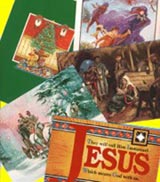 Henry Cole, an Englishman, was too busy to write personal greetings for Christmas 1843. Cole hired artist John Calcott Horsley to design a ready to be sent card. Henry Cole, an Englishman, was too busy to write personal greetings for Christmas 1843. Cole hired artist John Calcott Horsley to design a ready to be sent card.
The hand-colored card Horsley designed was
lithographedon stiff, dark cardboard and featured adults and children raising wine glasses in a toast. The first Christmas card also had various religious symbols.
Sprigsof holly symbolized chastity, while
ivysymbolized places God had walked. Feeding and clothing the poor were also encouraged on the card's cover. Under the picture was written "A Merry Christmas and a Happy New Year to you."
Printed in an edition of 1,000, Horsley's card was sold in London stores. Only one of those cards exists today.
Two reasons for the initial popularity of Christmas cards are given. The custom may have caught on because greetings could be mailed for a penny each in 1843, London. The other reason is attributed to a scandal with Horsley's design. A family, surrounded with religious symbols, holding glasses of wine, offended some. The controversy is thought to have helped promote Cole's idea.
How have Christmas cards changed to reflect trends and traditions?
In the late 19th century, cards were lavish, but didn't have the religious symbols present on either the original cards or the cards of today. The turn-of-the century saw European Christmas postcards that remained popular for the next 10 years.
Hand-painted cards, heavily influenced by the Art Deco movement were popular during the 1920s.
The Depression and the 1930s brought cards making fun of poverty and prohibition. The popularity of animated films brought characters like
Popeyeand Mickey Mouse onto cards for the first time.
A surge in Christmas cards came in the 1940s. During the World War II, friends and family, far away fighting, received cards with patriotic messages and symbols, like Uncle Sam. New technology allowed for more vivid cards.
The 1950s introduced humor. Santa was pictured as a
couch potatowatching television on one card. On a card whose message was "Peace on Earth," Santa had nuclear missiles over his head.
Untraditional cards took center stage in the 1960s, as Santa was poked fun at and peace symbols appeared on many cards. New inventions allowed cards to feature
embossingand
gold foil.
The 1970s had an athletic Santa to reflect the public's physical fitness
obsession. The United States'
bicentennialalso factored into Christmas cards with
nostalgicart, like that of Norman Rockwell. Religious cards also saw
resurgencewith the decades born again Christians.
Sophisticationwas big in the 1980's. The larger numbers of women in business led to more feminine designs. The cards took on the appearance of fine art as technology improved. As the public continued its thinness craze, pictures on cards showed a thinner Santa.
Traditionalism came back, to some extent, in the 1990s. Cards featured snow-covered landscapes, wreaths and Christmas trees. Messages promoting environmental concerns were also produced. Personalized cards done on computers reflected the customization trend.
The year 2000 relied on technology. Many card buyers used the Internet to order and send their Christmas cards, preventing the need to personally touch an envelope. However, those into tradition could still buy and mail their own cards.
|